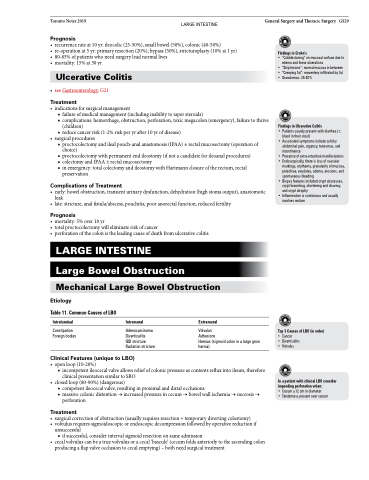Page 431 - TNFlipTest
P. 431
Toronto Notes 2019 LARGE INTESTINE
Prognosis
• recurrencerateat10yr:ileocolic(25-50%),smallbowel(50%),colonic(40-50%)
• re-operationat5yr:primaryresection(20%),bypass(50%),stricturoplasty(10%at1yr) • 80-85%ofpatientswhoneedsurgeryleadnormallives
• mortality:15%at30yr
Ulcerative Colitis
• seeGastroenterology,G21
Treatment
• indicationsforsurgicalmanagement
■ failure of medical management (including inability to taper steroids)
■ complications: hemorrhage, obstruction, perforation, toxic megacolon (emergency), failure to thrive
(children)
■ reduce cancer risk (1-2% risk per yr after 10 yr of disease)
• surgicalprocedures
■ proctocolectomy and ileal pouch-anal anastomosis (IPAA) ± rectal mucosectomy (operation of
choice)
■ proctocolectomy with permanent end ileostomy (if not a candidate for ileoanal procedures)
■ colectomy and IPAA ± rectal mucosectomy
■ in emergency: total colectomy and ileostomy with Hartmann closure of the rectum, rectal
preservation
Complications of Treatment
• early:bowelobstruction,transienturinarydysfunction,dehydration(highstomaoutput),anastomotic leak
• late:stricture,analfistula/abscess,pouchitis,pooranorectalfunction,reducedfertility
Prognosis
• mortality:5%over10yr
• totalproctocolectomywilleliminateriskofcancer
• perforationofthecolonistheleadingcauseofdeathfromulcerativecolitis
LARGE INTESTINE
Large Bowel Obstruction
Mechanical Large Bowel Obstruction
Findings in Crohn’s
• “Cobblestoning” on mucosal surface due to edema and linear ulcerations
• “Skip lesions”: normal mucosa in between
• “Creeping fat”: mesentery infiltrated by fat
• Granulomas: 25-30%
Findings in Ulcerative Colitis
• Patients usually present with diarrhea (± blood in their stool)
• Associated symptoms include colicky abdominal pain, urgency, tenesmus, and incontinence
• Presence of extra-intestinal manifestations • Endoscopically, there is loss of vascular
markings, erythema, granularity of mucosa, petechiae, exudates, edema, erosions, and spontaneous bleeding
• Biopsy features included crypt abscesses, crypt branching, shortening and disarray, and crypt atrophy
• Inflammation is continuous and usually involves rectum
General Surgery and Thoracic Surgery GS29
Etiology
Table 11. Common Causes of LBO
Intraluminal
Constipation Foreign bodies
Intramural
Adenocarcinoma Diverticulitis
IBD stricture Radiation stricture
Extramural
Volvulus
Adhesions
Hernias (sigmoid colon in a large groin hernia)
Top 3 Causes of LBO (in order)
• Cancer
• Diverticulitis • Volvulus
In a patient with clinical LBO consider impending perforation when:
• Cecum ≥12 cm in diameter
• Tenderness present over cecum
Clinical Features (unique to LBO)
• openloop(10-20%)
■ incompetent ileocecal valve allows relief of colonic pressure as contents reflux into ileum, therefore
clinical presentation similar to SBO • closedloop(80-90%)(dangerous)
■ competent ileocecal valve, resulting in proximal and distal occlusions
■ massivecolonicdistention→increasedpressureincecum→bowelwallischemia→necrosis→
perforation
Treatment
• surgicalcorrectionofobstruction(usuallyrequiresresection+temporarydivertingcolostomy)
• volvulusrequiressigmoidoscopicorendoscopicdecompressionfollowedbyoperativereductionif
unsuccessful
■ if successful, consider interval sigmoid resection on same admission
• cecalvolvuluscanbeatruevolvulusoracecal‘bascule’(cecumfoldsanteriorlytotheascendingcolon producing a flap valve occlusion to cecal emptying) – both need surgical treatment


